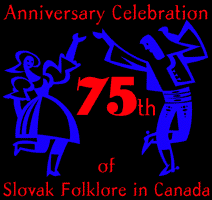 |
||||||||
Background |
||||||||
History |
||||||||
Tickets |
||||||||
|
|
||||||||||||
Folklore traditions are very important to Slovaks because the collective memory of the Slovak people is expressed through song, dance and other forms of creative endeavours. In addition, folklore is interwoven with ethnicity, and unique Slovak folklore traditions differentiate one group of people, a town or region, from others. With Slovaks coming to Canada from all corners of Slovakia, folklore became a vehicle for both expressing their individuality and as a means for identifying themselves as part of the collective group from specific regions of Slovakia. As the number of Slovaks kept increasing, folklore became a vehicle for mass entertainment. As the new immigrants started to integrate into the Canadian environment, they took something that was an integral part of their souls, beliefs and faith, and ventured to present Slovak folklore to Canadians. In this spirit, 75 years ago, the first Slovak Folklore group "Krivan" was established in Fort William (Thunder Bay), Ontario, to both promote Slovak heritage and to keep the spirit of Slovakia alive in the new community. The first major public display of Slovak Folklore took place at Thunder Bay's celebration of the 60th Anniversary of the Dominion of Canada. At these celebrations, the Slovak folklore group "Krivan" performed Slovak songs and dances as part of the official program. Their pioneering efforts lasted for 24 years and influenced other Slovak communities to form their own dance troupes. In 1942, Welland, Ontario, established their own dance troupe called "First Slovak Dancers". The original group was in existence for only two years but has been resurrected many times over the years under the name "Bratislava" even today, this group exists, with performers who are 3rd and 4th generation Slovaks. With the arrival of the 1950ís and a wave of new immigrants, the number of Slovak dance troupes also increased, with every major Slovak community claiming at least one dance troupe. Since those humble beginnings, Slovak Folklore, as personified by Canadian Slovak young men and women, has been presented and performed throughout Canada, the United States, numerous European countries and Slovakia. At any given time, there are between four and eight active Slovak folklore groups in Canada. |
All text and photographs copyright © 1998 - All rights reserved. |
||
